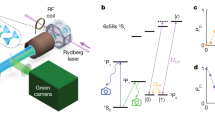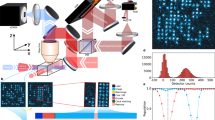Abstract
The establishment of a scalable scheme for quantum computing with addressable and long-lived qubits would provide a route to harnessing the laws of quantum physics to solve classically intractable problems. The design of many proposed platforms for quantum computing is driven by competing needs: isolating the quantum system from the environment to prevent decoherence, and easily and accurately controlling the system with external fields. For example, neutral-atom optical-lattice architectures provide environmental isolation through the use of states that are robust against fluctuating external fields, yet external fields are essential for qubit addressing. Here, we demonstrate the selection of individual qubits with external fields, while the qubits are in field-insensitive superpositions. We use a spatially inhomogeneous external field to map selected qubits to a different field-insensitive superposition, minimally perturbing unselected qubits, despite the fact that the addressing field is not spatially localized. We show robust single-qubit rotations on neutral-atom qubits located at selected lattice sites. This precise coherent control should be more generally applicable to state transfer and qubit isolation in other architectures using field-insensitive qubits.
This is a preview of subscription content, access via your institution
Access options
Subscribe to this journal
Receive 12 print issues and online access
$209.00 per year
only $17.42 per issue
Buy this article
- Purchase on Springer Link
- Instant access to full article PDF
Prices may be subject to local taxes which are calculated during checkout





Similar content being viewed by others
References
Brennen, G. K., Caves, C. M., Jessen, P. S. & Deutsch, I. H. Quantum logic gates in optical lattices. Phys. Rev. Lett. 82, 1060–1063 (1999).
Jaksch, D., Briegel, H.-J., Cirac, J. I., Gardiner, C. W. & Zoller, P. Entanglement of atoms via cold controlled collisions. Phys. Rev. Lett. 82, 1975–1978 (1999).
Bloch, I. Exploring quantum matter with ultracold atoms in optical lattices. J. Phys. B 38, S629 (2005).
Nelson, K. D., Li, X. & Weiss, D. S. Imaging single atoms in a three-dimensional array. Nature Phys. 3, 556–560 (2007).
Beugnon, J. et al. Two-dimensional transport and transfer of a single atomic qubit in optical tweezers. Nature Phys. 3, 696–699 (2007).
Schrader, D. et al. Neutral atom quantum register. Phys. Rev. Lett. 93, 150501 (2004).
Jaksch, D., Bruder, C., Cirac, J. I., Gardiner, C. W. & Zoller, P. Cold Bosonic atoms in optical lattices. Phys. Rev. Lett. 81, 3108–3111 (1998).
Mandel, O. et al. Controlled collisions for multi-particle entanglement of optically trapped atoms. Nature 425, 937–940 (2003).
Hayes, D., Julienne, P. S. & Deutsch, I. H. Quantum logic via the exchange blockade in ultracold collisions. Phys. Rev. Lett. 98, 070501 (2007).
Anderlini, M. et al. Controlled exchange interaction between pairs of neutral atoms in an optical lattice. Nature 448, 452–456 (2007).
Zhang, C., Rolston, S. L. & Sarma, S. D. Manipulation of single neutral atoms in optical lattices. Phys. Rev. A 74, 042316 (2006).
Lee, P. J. et al. Sublattice addressing and spin-dependent motion of atoms in a double-well lattice. Phys. Rev. Lett. 99, 020402 (2007).
Weiss, D. S. et al. Another way to approach zero entropy for a finite system of atoms. Phys. Rev. A 70, 040302 (2004).
Imamoglu, A. et al. Quantum information processing using quantum dot spins and cavity QED. Phys. Rev. Lett. 83, 4204–4207 (1999).
Taylor, J. et al. Fault-tolerant architecture for quantum computation using electrically controlled semiconductor spins. Nature Phys. 1, 177–183 (2005).
Sebby-Strabley, J., Anderlini, M., Jessen, P. S. & Porto, J. V. Lattice of double wells for manipulating pairs of cold atoms. Phys. Rev. A 73, 033605 (2006).
Matthews, M. R. et al. Dynamical response of a Bose–Einstein condensate to a discontinuous change in internal state. Phys. Rev. Lett. 81, 243–247 (1998).
Ramsey, N. F. A molecular beam resonance method with separated oscillating fields. Phys. Rev. 78, 695–699 (1950).
Katori, H., Takamoto, M., Pal’chikov, V. G. & Ovsiannikov, V. D. Ultrastable optical clock with neutral atoms in an engineered light shift trap. Phys. Rev. Lett. 91, 173005 (2003).
Rosenbusch, P. et al. A.c. Stark shift of the Cs microwave atomic clock transitions. Phys. Rev. A 79, 013404 (2009).
Flambaum, V. V., Dzuba, V. A. & Derevianko, A. Magic frequencies for cesium primary-frequency standard. Phys. Rev. Lett. 101, 220801 (2008).
Campbell, G. K. et al. Imaging the Mott insulator shells by using atomic clock shifts. Science 313, 649–652 (2006).
Uhrig, G. S. Keeping a quantum bit alive by optimized pi-pulse sequences. Phys. Rev. Lett. 98, 100504 (2007).
Biercuk, M. J. et al. Optimized dynamical decoupling in a model quantum memory. Nature 458, 996–1000 (2009).
Deutsch, I. et al. Quantum transport in magneto-optical double-potential wells. J. Opt. B 2, 633–644 (2000).
Lundblad, N. et al. Atoms in a radio-frequency-dressed optical lattice. Phys. Rev. Lett. 100, 150401 (2008).
Mandel, O. et al. Coherent transport of neutral atoms in spin-dependent optical lattice potentials. Phys. Rev. Lett. 91, 010407 (2003).
Levitt, M. Composite pulses. Prog. Nucl. Magn. Reson. Spectrosc. 18, 61–122 (1986).
Cummins, H. K., Llewellyn, G. & Jones, J. A. Tackling systematic errors in quantum logic gates with composite rotations. Phys. Rev. A 67, 042308 (2003).
Rakreungdet, W. et al. Accurate microwave control and real-time diagnostics of neutral-atom qubits. Phys. Rev. A 79, 022316 (2009).
Knill, E. et al. Randomized benchmarking of quantum gates. Phys. Rev. A 77, 012307 (2008).
Gerlach, W. & Stern, O. Der experimentelle nachweis der richtungsquantelung im magnetfeld. Z. Phys. A 9, 349–532 (1922).
Acknowledgements
We thank W. D. Phillips for a critical reading, P. Jessen and I. Deutsch for helpful discussion and S. Swift and E. Huang for technical assistance with our direct-digital-synthesis hardware. This work was partially supported by DTO and ONR. N.L. acknowledges support from the National Research Council Research Associateship program.
Author information
Authors and Affiliations
Corresponding author
Rights and permissions
About this article
Cite this article
Lundblad, N., Obrecht, J., Spielman, I. et al. Field-sensitive addressing and control of field-insensitive neutral-atom qubits. Nature Phys 5, 575–580 (2009). https://doi.org/10.1038/nphys1330
Received:
Accepted:
Published:
Issue Date:
DOI: https://doi.org/10.1038/nphys1330
This article is cited by
-
Super Dense Coding with Dark-Soliton Qubits
International Journal of Theoretical Physics (2022)
-
Generation and detection of atomic spin entanglement in optical lattices
Nature Physics (2016)
-
Robust site-resolvable quantum gates in an optical lattice via inhomogeneous control
Nature Communications (2013)
-
Speeding up the spatial adiabatic passage of matter waves in optical microtraps by optimal control
Quantum Information Processing (2013)
-
Single-spin addressing in an atomic Mott insulator
Nature (2011)



